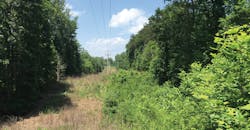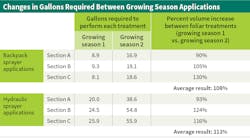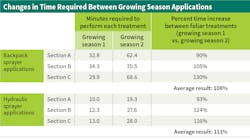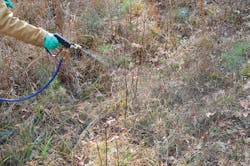Minimize the Cost Impact of Maintenance Delays
You are only delaying the inevitable. This phrase holds true whether it is about a long overdue visit to the dentist or finally having a mechanic check out the unnatural noise coming from a truck’s engine. Both scenarios can result in a higher-than-anticipated bill. Sometimes the final bill can make a person regret not acting sooner.
For utility managers, this phrase could apply to the decision to delay vegetation management treatments on rights-of-way (ROW). Few would debate it is costlier to treat brush when it has been allowed to grow taller and denser. However, until now, there has not been any measure of how much costlier it is. Initial results from a first-of-its-kind study show the increased costs may be more significant than many realize.
Initiated and led by Dow AgroSciences, the study began in 2016 and continues to be performed today on Santee Cooper ROW, in cooperation with the publicly owned electric utility. The goals of the study are to get a clearer understanding of tangible costs associated with skipping vegetation management for a year; to help ROW managers to make more informed decisions and defend vegetation management budgets; and to determine good alternatives to delayed maintenance.
Adding to the Cost
Managing incompatible vegetation along utility ROW corridors can be a costly and complex endeavor — especially initially — requiring careful consideration around work planning, budgeting and resource allocation to plan and implement effective vegetation management maintenance cycles.
When these inputs are not aligned, the decision may be made to postpone planned maintenance to the following growing season or even beyond. While the delay solves a short-term problem, many times it comes with little to no consideration of future cost implications or fails to account for the increased visibility and potential scrutiny from landowners around later treatment of larger, denser brush.
One question to consider is would vegetation management maintenance be postponed as frequently if vegetation managers had more data on the longer-term budget implications, along with proven alternatives to delaying treatment? To help provide answers, Dow AgroSciences initiated an original study using simulated ROW herbicide treatments.
The study was implemented on a stretch of Santee Cooper transmission ROW at a site in coastal South Carolina. The selected site had been managed using a continuous mowing program, was last mowed in May 2014, and then had been left untouched until the study began in 2016. The study area was divided in three sections: A, B and C. Each section received a simulated herbicide treatment using two different types of application equipment: backpack sprayers and a hydraulic sprayer mounted on a utility-terrain vehicle.
The first treatments were made during the 2016 growing season (foliar application), the second during the winter season of 2017 (dormant application) and the third during the 2017 growing season (foliar application).
For all simulated applications, water was used to treat incompatible brush. This was done to enable future simulated treatments to be made to the same areas, thereby accounting for actual growth in the site’s incompatible brush. The material and time needed to treat each section was recorded as well as the stem densities. Section A had an estimated stem count of 4,300 stems per acre, section B had 5,000 stems per acre and section C had 2,800 stems per acre.
What the Results Show
Analyzing the initial study results points to significant cost increases when treating the same acre after delaying maintenance by a single growing season. This was determined by looking at two key metrics: material and time.
Specifically reviewed was the amount of material necessary to treat incompatible brush for each application technique and treatment interval. The time metric was calculated as a function of the volume of material applied by the gallons per minute for each application technique.
In late June 2017, an assessment was done to determine the level of growth in incompatible brush — primarily red maple, water oak, loblolly pine and sweetgum — since the previous growing season. The 4-D vegetative growth was observed as averaging 20 inches across species and sites.
Not surprisingly, after reviewing the recorded amounts of material and time needed to complete the growing season (two foliar treatments), there was a direct correlation between an increase in brush size and density, and an increase in the volume of material and time needed to treat it. It was surprising how dramatic the increase was. When averaged across all three sections, treating the additional growth required 108% more material per acre when using backpack sprayers and 111% more material per acre when using hydraulic equipment.
Also surprising was that increases in time needed for treatments — which did not include time needed to refill — mirrored material increases over the same period, on average 108% more time for backpack applications and 111% more time for hydraulic applications.
While the study results are striking, it should be noted actual results could vary from one ROW to the next based on several factors, including previous methods of maintenance, weather, stem densities and brush species present. Converting ROW from a mow-only approach to a more integrated vegetation management program using herbicide treatments may experience higher initial cost increases based on brush density because, as stem densities are reduced, the costs to maintain the ROW will decrease proportionally over time.
Flexible Alternatives
The research also uncovered a cost-effective alternative to season-long treatment delays: dormant season applications. On average, 20% less material and time were needed to complete the dormant season treatments in comparison to foliar treatments made during the first growing season, followed by 169% less in comparison to foliar treatments in the second growing season.
In addition, dormant-stem treatments have been shown to do the following:
• Reduce potential for public scrutiny
• Enable better management of workforce planning and budget fluctuations
• Help to retain valued application crews with continued work during traditional downtime.
From late fall to early spring, dormant-stem treatments enable the application season for brush control to begin at fall leaf drop and continue until early bud break. This timing offers the opportunity to align budget funding more with ROW maintenance and the ability to reallocate work crews from late in the season, when many crews are typically shutting down, to early in the season.
Because the application occurs during the dormant season — when deciduous woody plants have dropped their leaves — visibility is reduced significantly when comparing against the brownout of treated brush, which appears as a result of many growing season applications. This reduced public visibility can lessen exposure to scrutiny and potential complaints. Additionally, if dormant-stem applications are made using herbicides that are selective to grasses and other desirable plants, this desirable vegetation will work to provide a biological barrier of sorts against woody plant establishment.
But do dormant-stem treatments control incompatible brush on ROW as well as foliar treatments? Dow AgroSciences has found utilities using these treatments correctly have seen anywhere from 85% or better control on hardwoods such as maple and oak as well as conifers such as pine. It is highly recommended applicators be trained specifically in this application technique, as control results are tightly aligned to proper application. Dormant-stem applications are best suited for low to moderate stem density and brush that is mostly head high or lower.
If a site has brush with lower stem densities and larger diameters, another dormant season treatment option is low-volume basal bark applications. Such treatments are best suited in areas where brush density is lower than 500 stems per acre and brush is larger, up to 6 inches in diameter.
Future Plans
Results from the initial study were so compelling additional research has been initiated at a new site to carry similar data collection over a three-year period while starting earlier in the maintenance cycle. Final study results will be published by Dow AgroSciences in cooperation with participating partners and made available in the future. ♦
Travis W. Rogers is a market development specialist for Dow AgroSciences’ pasture and land management business. Based in Charleston, South Carolina, Rogers has worked for Dow AgroSciences for 22 years and currently serves as a liaison for the field sales, marketing, and research and development organizations to better align to customers’ needs.
Patrick L. Burch is a field scientist for Dow AgroSciences. Based in Christiansburg, Virginia, Burch has worked for Dow AgroSciences for 32 years as a field scientist and technical resource to customers, cooperators and field sales. His responsibilities have included herbicide research, stewardship and uses in vegetation management for rights-of-way, forestry, aquatic habitats, invasive plant control, range and pasture as well as product development.
William F. Brunson is superintendent of right-of-way management for Santee Cooper, based in Moncks Corner, South Carolina. He started with the utility as a transmission lineman, where he spent 13 years, and then transitioned to vegetation maintenance, where he has served for the last 15 years managing transmission ROW across South Carolina. He holds a bachelor’s degree in business management from Limestone College.
J. Parker Hill is a supervisor of right-of-way management for Santee Cooper, based in Moncks Corner, South Carolina. His career spans nearly 24 years in vegetation management on transmission ROW throughout South Carolina. Prior to joining Santee Cooper in 1994, Hill was a land management forester for the Union Camp Corp. He holds a bachelor’s degree in forest management from Clemson University.
Randal S. Osteen is a supervisor of right-of-way management for Santee Cooper, based in Moncks Corner, South Carolina. His professional experience spans 26 years in the construction and utility industry. For the last 14 years, he has been with Santee Cooper and currently supervises all vegetation maintenance on the ground floor of the utility’s transmission system, including mechanical reclearing and whole line spray operations.
Editor’s note: Questions and requests for study updates or more detailed results can be sent to [email protected].
About the Author
Travis W. Rogers
Travis W. Rogers is a market development specialist for Corteva Agriscience within the Eastern U.S. Pasture & Land Management District. In his role, he supports 11 territory managers and serves as the interface between the commercial sales and R&D units. He has 15 years of experience working with energy companies, federal and state agencies, conservation groups, channel partners and service contractors within the rights-of-way and forestry industries. He is based in Charleston, South Carolina.
J. Parker Hill
J. Parker Hill is a supervisor of right-of-way management for Santee Cooper based in Moncks Corner, South Carolina. His career spans nearly 24 years in vegetation management on transmission ROW throughout South Carolina. Prior to joining Santee Cooper in 1994, Hill was a land management forester for the Union Camp Corp. He holds a bachelor’s degree in forest management from Clemson University.
Randal S. Osteen
Randal S. Osteen is a supervisor of right-of-way management for Santee Cooper based in Moncks Corner, South Carolina. His professional experience spans 26 years in the construction and utility industry. For the last 14 years, he has been with Santee Cooper and currently supervises all vegetation maintenance on the ground floor of the utility’s transmission system, including mechanical reclearing and whole line spray operations.






